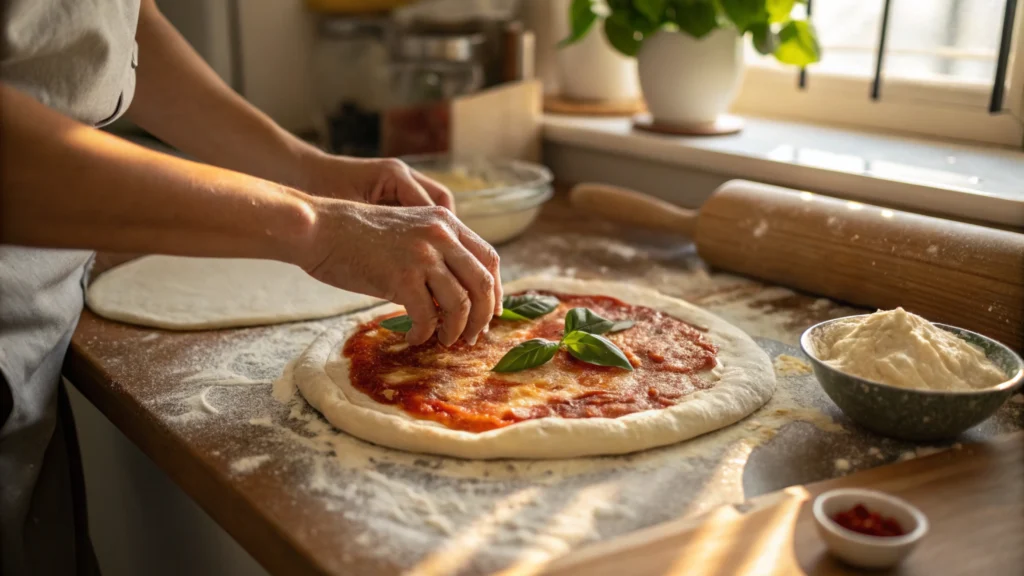The Margherita pizza is an example of simplicity and perfection, capturing the essence of Italian cuisine. The vibrant and colourful ingredients – ripe San Marzano tomatoes, creamy fresh mozzarella, and scrumptious basil leaves- are visually stunning and symbolize the colours that make up the Italian flag. In this article, we’ll travel through its rich history as we explore the unique aspects of it and discover how to make it at your home. Whether you’re a pizza fan or are just beginning your culinary journey and learning about pizza, you’ll find all you must learn about this renowned dish.
The Origin and History of Margherita Pizza
Margherita pizza Margherita pizza is much more than an excellent dish. It’s a slice of Italian history that is baked into a crust. Its origins return to Naples, Italy, and its history is as fascinating as the pizza.
The Birth of Margherita Pizza
In 1889, Queen Margherita of Savoy was in Naples during her royal visit. The city, known for its pizzas made of rustic ingredients and pies, wanted to pay a unique tribute to the queen. Chef Raffaele Esposito from Pizzeria Brandi created a pizza with mozzarella cheese, tomato sauce, and freshly cut basil leaves. The white, red, and green toppings reflected that of the Italian flag and paid homage to the Queen’s patriotic spirit. She was so fond of the pizza that was named after her.
Naples: The Heart of Margherita Pizza
Naples has been long considered as the place where pizza was invented, and the Margherita is a significant part of the history of its cuisine. Neapolitan pizza culture thrives in bustling pizzerias, where chefs follow strict rules to create the perfect pizza. Iconic spots like Gino Sorbillo and Via Tribunali keep the authentic Neapolitan experience alive by serving pizzas featuring crisp, crispy crusts with fresh, quality ingredients.
The Ingredients That Make Margherita Pizza Special
Key Ingredients
- San Marzano Tomatoes: The Soul of the Sauce
- They are renowned due to their sweet and subtle acidity. San Marzano tomatoes are the centre of any traditional Margherita pizza. They are grown in the volcanic soils in Italy’s Campania region. These tomatoes are coveted because of their deep, rich taste. They are typically crushed or pureed into an uncomplicated yet delicious sauce.
- Fresh Mozzarella: A Creamy Essential
- The soft, creamy texture of fresh mozzarella makes Margherita pizza different from other types. Mozzarella di bufala, made from water buffalo, is a favourite option for its delicious taste. It melts wonderfully and creates little pockets of delicious gooeyness throughout the pizza.
- Basil: The Fragrant Finishing Touch
- A few freshly cut basil leaves add to the Margherita pizza’s taste profile. The simple herb imparts the pizza with a sweet, peppery flavour that lifts the whole pizza. It’s usually added to pizzas after baking in order to preserve its vivid colour and aroma.
Importance of Quality
When you’re making Margherita pizza, the ingredients should shine. The freshness and authenticity of the ingredients are essential. Substituting ingredients, such as regular tomatoes or pre-shredded cheese, is possible; however, they will not replicate the original charm. Using top-quality olive oil to drizzle adds an elegant, fruity flavour that enhances every bite.
Step-by-Step Guide to Making Margherita Pizza at Home

Making Margherita pizza in your kitchen is a fine art that isn’t difficult to master by following a few easy steps. This is how you can transform your kitchen into an authentic Neapolitan pizzeria.
Preparing the Dough
- Ingredients and Their Roles
- The basic pizza dough comprises yeast, flour, olive oil, water, and salt. It is essential to use high-gluten flour for a soft but crisp crust.
- Kneading and Proofing Techniques
- Make sure the dough is elastic and smooth and takes around 8-10 minutes. Then, allow it to rise in a warm area for a minimum of two hours. This time of rest lets the dough form its unique airy texture.
Making the Perfect Sauce
- Selecting the Best Tomatoes
- Make use of canned San Marzano tomatoes for convenience and taste. Crush or blend them with your hands to create a smoother consistency.
- Enhancing Flavors with only a few ingredients
- Add salt, oil, ve oil, and a pinch of garlic. Be careful not to overpower the naturally sweet taste of tomatoes by using too many seasonings.
Assembling the Pizza
- Stretching and Shaping the Dough
- The dough can be stretched or rolled into a thin, circular form, ensuring the edges are thicker for a classic sourdough crust. Dust the surface with semolina to avoid sticking.
- Layering Ingredients for Balance
- Place a thin layer of sauce over the dough, leaving some space along the edges. Include slices of mozzarella and some basil leaves. Be mindful that less is more. Each ingredient must shine.
Baking Tips for the Perfect Crust
- The Role of Baking Stones and Steels
- Pizza stones or steel can recreate the intense temperature of a wood-fired oven. Preheat the oven to the most extreme temperature for at least 30 minutes.
- Achieving the Right Temperature and Texture
- The pizza is baked at 500 degrees F (260 degrees C) till the pizza is golden brown and the cheese has melted, typically about 7-8 minutes. A quick broil may give the pizza a little char to ensure authenticity.
To explore more pizza recipes, check out this guide to pizza oven recipes on Flavory Cook for additional inspiration.
The Difference Between Margherita and Other Pizzas
Margherita Pizza has created its own identity in the multitude of pizza types available worldwide. The simplicity of the pizza and its authenticity make it different from other types of pizza.
Margherita vs. Regular Pizza
- Focus on Simplicity
- In contrast to traditional pizzas, which often include a variety of toppings, Margherita pizza is an uncluttered creation. It focuses on three primary ingredients: mozzarella cheese, tomato sauce, and fresh basil. This allows each flavour to shine, while traditional pizzas could be overwhelming with lots of toppings.
- Authenticity in Ingredients
- Traditional Margherita pizza is made with San Marzano tomatoes and mozzarella di bufala, the main ingredients from its Neapolitan origin. Regular pizzas typically rely on essential ingredients that may alter the flavour and texture.
Neapolitan Standards
- Adhering to Tradition
- Margherita Pizza is subject to strict standards by the Associazione Verace Pizza Napoletana (AVPN). This includes the method of making the dough, the selection of toppings, and the method of baking the pizza in a wood-fired oven with high temperatures.
- Certification of Authenticity
- Some pizzas are not Neapolitan-style. Margherita Pizza must comply with AVPN requirements to qualify as authentic Neapolitan pizza, which guarantees the same flavour and quality.
Regional Variations
- Interpretations Across the World
- Although Margherita Pizza was the source of inspiration for many variations, its fundamentals remain the same. Modern versions often feature exotic toppings such as cherry tomatoes and burrata cheese; however, they differ from the classic recipe.
For more delicious pizza ideas, check out the pizza toast recipe guide on Flavory Cook for a creative twist on pizza classics.
Why Margherita Pizza Is So Beloved
The Appeal of Simplicity
- A Harmony of Flavors
- Margherita Pizza is a perfect example of how simple ingredients can produce something unique. The tart tomato sauce, soft mozzarella, and aromatic basil blend perfectly and make each bite memorable.
- A Visual and Sensory Delight
- The vivid colours of white, red and vibrant green toppings do not just symbolize the Italian flag but also make an appealing display. Its simple design shows its freshness and provides an exciting feast for the eyes and the palate.
A Celebration of Italian Culture
- Heritage in Every Slice
- Margherita pizza is more of a food item; it expresses Italian confidence and culinary excellence. It reflects the Italian concept of letting ingredients speak for themselves. This concept is rooted in the past.
- A Dish That Tells a Story
- From its humble beginnings in Naples to its international popularity, Margherita Pizza carries a history of quality and authenticity. Its long-running popularity confirms the world’s admiration for Italian food.
Versatility and Universal Appeal
- Loved by All Ages
- Whether you’re a kid or an adult, Margherita pizzas are universally delicious. The mild flavour will please the crowd at any event.
- Adaptable to Personal Tastes
- Although the traditional recipe is loved by many, Margherita pizza also lends its flavour to subtle variations. Add a pinch of chilli flakes or a drop of truffle oil, and the pizza transforms into delicious food.
Tips for Serving and Pairing Margherita Pizza
The best Margherita pizza experience isn’t only about how you cook it but equally about how you serve it and serve it with your favourite drinks.
Serving Suggestions

- Slicing for Easy Sharing
- Cut the pizza into equal pieces, ensuring every slice has a balanced amount of toppings. Pizza wheels are the best for making clean cuts without tearing the cheese.
- Presenting Style
- Serving your meal on a wood platter or pizza stone to preserve the warmth and provide an earthy flavour. Add a few fresh basil leaves and a drizzle of extra-virgin olive oil just before serving to add a taste.
- Timing Matters
- Margherita pizza is delicious when served hot straight out of the oven. Fresh mozzarella melts beautifully, and the crust stays fresh and crisp.
Combining wine with other Drinks
- Classic Italian Pairings
- Drinking a chilled glass of white wine such as Pinot Grigio or a light-bodied red wine like Chianti will complement the simple taste of Margherita pizza. The wine’s acidity balances the cheese’s richness and sweetness and the delicious tomato sauce.
- Alternative Beverages
- Suppose you are looking for alternatives that aren’t alcoholic. In that case, sparkling water with the zest of a lemon or a refreshing iced tea can be an excellent combination. If you want to indulge in a more luxurious drink that includes an artisan soda, delicate citrus notes can add a touch of sweetness to the flavour.
FAQs About Margherita Pizza
What Defines a Margherita Pizza?
Margherita pizzas have three ingredients: tomato sauce, fresh mozzarella, and basil. The ingredients are selected to show their superiority and symbolize the Italian flag’s colours: white, red and green.
Is Margherita Pizza Just Cheese and Tomato?
Although it might appear simple, Margherita’s pizza is more than just tomatoes and cheese. Fresh basil, paired with premium mozzarella and authentic San Marzano tomatoes, creates an appetizer that’s more complicated than it seems.
What’s the Difference Between Margherita Pizza and Regular Pizza?
The primary difference lies in its simplicity and authenticity. The typical pizza will have a range of toppings, from meats to vegetables. Contrarily, Margherita Pizza emphasizes minimalism by letting every ingredient shine without obscuring the others.
Why Is Pizza Margherita So Good?
Its perfect taste is in the harmony of flavours. The tomato sauce’s tangy flavour, creamy mozzarella, and fragrant basil all work in harmony. The lightly crispy crust provides the flavour, making each bite memorable and satisfying.
Final Thoughts on Margherita Pizza
Margherita pizza isn’t only a meal; it’s a celebration of traditionality, taste, and tradition. The longevity of its popularity shows that the most delicious recipes usually require a few top-quality ingredients.
A Timeless Favorite
From its beginnings in Naples and its place everywhere, Margherita Pizza has remained an icon of food. Its appeal is in its capacity to provide bold tastes with little effort, demonstrating the simplicity of cooking.
Your Turn to Try It
If you’re familiar with the origins, ingredients and techniques behind Margherita pizza, Why not make your own? If you’re using a classic recipe or incorporating your own twist, this pizza is sure to satisfy with each bite.
To get more pizza ideas, check out our pizza oven recipe section and discover other delicious options.

Authentic Margherita Pizza
Ingredients
Equipment
Method
- Step 1: Prepare the Dough
- In a small bowl, mix warm water, sugar, and yeast. Let it sit for 5–10 minutes until foamy.
- In a large mixing bowl, combine flour and salt.
- Gradually add the yeast mixture and olive oil, mixing until a dough forms.
- Knead the dough on a floured surface for 8–10 minutes until smooth and elastic.
- Place the dough in a lightly oiled bowl, cover, and let it rise in a warm place for 2 hours or until doubled in size.
- Step 2: Make the Sauce
- In a bowl, mix crushed San Marzano tomatoes with olive oil, salt, and oregano.
- Stir well and set aside. The sauce requires no cooking, keeping the flavors fresh.
- Step 3: Preheat the Oven & Prepare the Pizza
- Preheat your oven to 500°F (260°C). If using a pizza stone or steel, place it in the oven and let it heat for 30 minutes.
- Punch down the dough and divide it into two portions.
- On a lightly floured surface (or semolina-dusted surface), stretch the dough into a 12-inch circle, keeping the edges slightly thicker for the crust.
- Step 4: Assemble the Pizza
- Spread 2–3 tbsp of tomato sauce evenly over the dough, leaving about ½ inch of crust exposed.
- Distribute fresh mozzarella pieces over the pizza.
- Add a few basil leaves for flavor.
- Step 5: Bake the Pizza
- Transfer the pizza onto the preheated pizza stone or baking sheet.
- Bake for 7–9 minutes, or until the crust is golden brown and slightly charred, and the cheese is melted and bubbly.
- Drizzle with extra virgin olive oil and garnish with more fresh basil leaves after baking.
- Step 6: Serve & Enjoy
- Slice the pizza and serve hot! Pair with a glass of white wine or a refreshing Italian soda for an authentic experience.
Notes
For a smoky, authentic flavor, cook the pizza in a wood-fired oven if possible.
Experiment with variations by adding cherry tomatoes or a drizzle of balsamic glaze.
This classic Margherita pizza is simple yet divine—an authentic taste of Naples in every bite! 🍕🇮🇹 Let me know if you’d like a gluten-free or whole wheat version!


2 thoughts on “Margherita Pizza: Simplicity and Flavor”